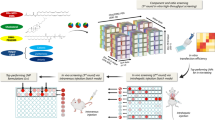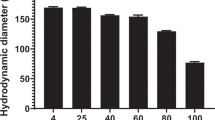Abstract
Polyethylenimine (PEI) has been studied as an efficient nonviral gene transfer vector. Here, we report the biodistribution fates and safety of plasmid DNA intravenously administered in PEI complexes. Using pCMVβ as a model gene, the biodistribution of plasmid DNA was measured by quantitative polymerase chain reaction. A deletion mutant of pCMVβ was used as an internal standard. After intravenous administration of PEI/DNA complexes, the serum levels of DNA rapidly declined for up to 15 min. However, after this point, the serum levels of DNA diminished slowly. At 15 min after dose, PEI/DNA complexes showed 33-fold higher distribution of DNA in the lung than did naked DNA. At 24 h, all the organs tested showed much higher levels of plasmid DNA in PEI/DNA complexes, with distribution in the liver and lung being three orders of magnitude higher than naked DNA. The mRNA expression of DNA was observed in various organs of PEI/DNA-treated mice at 12 days after dose. Once a week dosing of PEI/DNA complexes over 3 consecutive weeks did not alter the histology of the organs. However, twice a week dosing over 3 weeks induced a sign of inflammation in the liver. These results indicate that PEI enhances the delivery and retention of plasmid DNA in the organs, especially the liver, but that safe delivery requires proper dosing intervals.
This is a preview of subscription content, access via your institution
Access options
Subscribe to this journal
Receive 12 print issues and online access
$259.00 per year
only $21.58 per issue
Buy this article
- Purchase on Springer Link
- Instant access to full article PDF
Prices may be subject to local taxes which are calculated during checkout







Similar content being viewed by others
References
Boussif O et al. A versatile vector for gene and oligonucleotide transfer into cells in culture and in vivo: polyethylenimine Proc Natl Acad Sci USA 1995 92: 7297–7301
Ringenbach L et al. Polyethylenimine-mediated transfection of human monocytes with the IFN-γ gene: an approach for cancer adoptive immunotherapy Gene Therapy 1998 5: 1508–1516
Diebold SS et al. Efficient gene delivery into human dendritic cells by adenovirus polyethylenimine and mannose polyethylenimine transfection Hum Gene Ther 1999 10: 775–786
Dodds E, Piper TA, Murphy SJ, Dickson G . Cationinc lipids and polymers are able to enhance adenoviral infection of culture mouse myotubes J Neurochem 1999 72: 2105–2112
Bandyopadhyay P et al. Nucleotide exchange in genomic DNA of rat hepatocytes using RNA/DNA oligonucleotides: targeted delivery of liposomes and polyethylenimine to the asialoglycoprotein receptor J Biol Chem 1999 274: 10163–10172
Boletta A et al. Nonviral gene delivery to the rat kidney with polyethylenimine Hum Gene Ther 1997 8: 1243–1251
Chemin I et al. Liver-directed gene transfer: a linear polyethyleneimine derivative mediates highly efficient DNA delivery to primary hepatocytes in vitro and in vivo J Viral Hepatitis 1998 5: 369–375
Ferrari S et al. ExGen 500 is an efficient vector for gene delivery to lung epithelial cells in vitro and in vivo Gene Therapy 1997 4: 1100–1106
Abdallah B et al. A powerful nonviral vector for in vivo gene transfer into the adult mammalian brain: polyethylenimine Hum Gene Ther 1996 7: 1947–1954
Oh YK et al. Nasal absorption and biodistribution of plasmid DNA: an alternative route of DNA vaccine delivery Vaccine 2001 19: 4519–4525
Lew D et al. Cancer gene therapy using plasmid DNA: pharmacokinetic study of DNA following injection in mice Hum Gene Ther 1995 6: 553–564
Godbey WT et al. Poly(ethylenimine)-mediated transfection: a new papradigm for gene delivery J Biomed Mater Res 2000 51: 321–328
Osaka G et al. Pharmacokinetics, tissue distribution, and expression efficiency of plasmid [33P]DNA following intravenous administration of DNA/cationic lipid complexes in mice: use of a novel radionuclide approach J Pharm Sci 1996 85: 612–618
Kawabata K, Takakura Y, Hashida M . The fate of plasmid DNA after intravenous injection in mice: involvement of scavenger receptors in its hepatic uptake Pharm Res 1995 12: 825–830
Goula D et al. Rapid crossing of the pulmonary endothelial barrier by polyethylenimine/DNA complexes Gene Therapy 2000 7: 499–504
Klemm AR, Young D, Lloyd JB . Effects of polyethylenimine on endocytosis and lysosome stability Biochem Pharmacol 1998 56: 41–46
Plank C, Mechtler K, Szoka F, Wagner E . Activation of the complement system by synthetic DNA complexes Hum Gene Ther 1996 7: 1437–1446
Oral HB et al. Ex vivo adenovirus-mediated gene transfer and immunomodulatory protein production in human cornea Gene Therapy 1997 4: 639–647
Acknowledgements
This work was supported by a grant of the Korea Health 98 R&D Project, Ministry of Health & Welfare, Republic of Korea (HMP-98-D-5–0048).
Author information
Authors and Affiliations
Rights and permissions
About this article
Cite this article
Oh, YK., Kim, JP., Yoon, H. et al. Prolonged organ retention and safety of plasmid DNA administered in polyethylenimine complexes. Gene Ther 8, 1587–1592 (2001). https://doi.org/10.1038/sj.gt.3301516
Received:
Accepted:
Published:
Issue Date:
DOI: https://doi.org/10.1038/sj.gt.3301516
Keywords
This article is cited by
-
Transfection using hydroxyapatite nanoparticles in the inner ear via an intact round window membrane in chinchilla
Journal of Nanoparticle Research (2012)
-
Preclinical Pharmacokinetics and Biodistribution of Human Papillomavirus DNA Vaccine Delivered in Human Endogenous Retrovirus Envelope-Coated Baculovirus Vector
Pharmaceutical Research (2012)
-
Antifibrotic Effect of MMP13-encoding Plasmid DNA Delivered Using Polyethylenimine Shielded With Hyaluronic Acid
Molecular Therapy (2011)
-
Evaluation of Pharmacokinetics of Bioreducible Gene Delivery Vectors by Real-time PCR
Pharmaceutical Research (2009)
-
Systemic Delivery of DNA or siRNA Mediated by Linear Polyethylenimine (L-PEI) Does Not Induce an Inflammatory Response
Pharmaceutical Research (2008)



